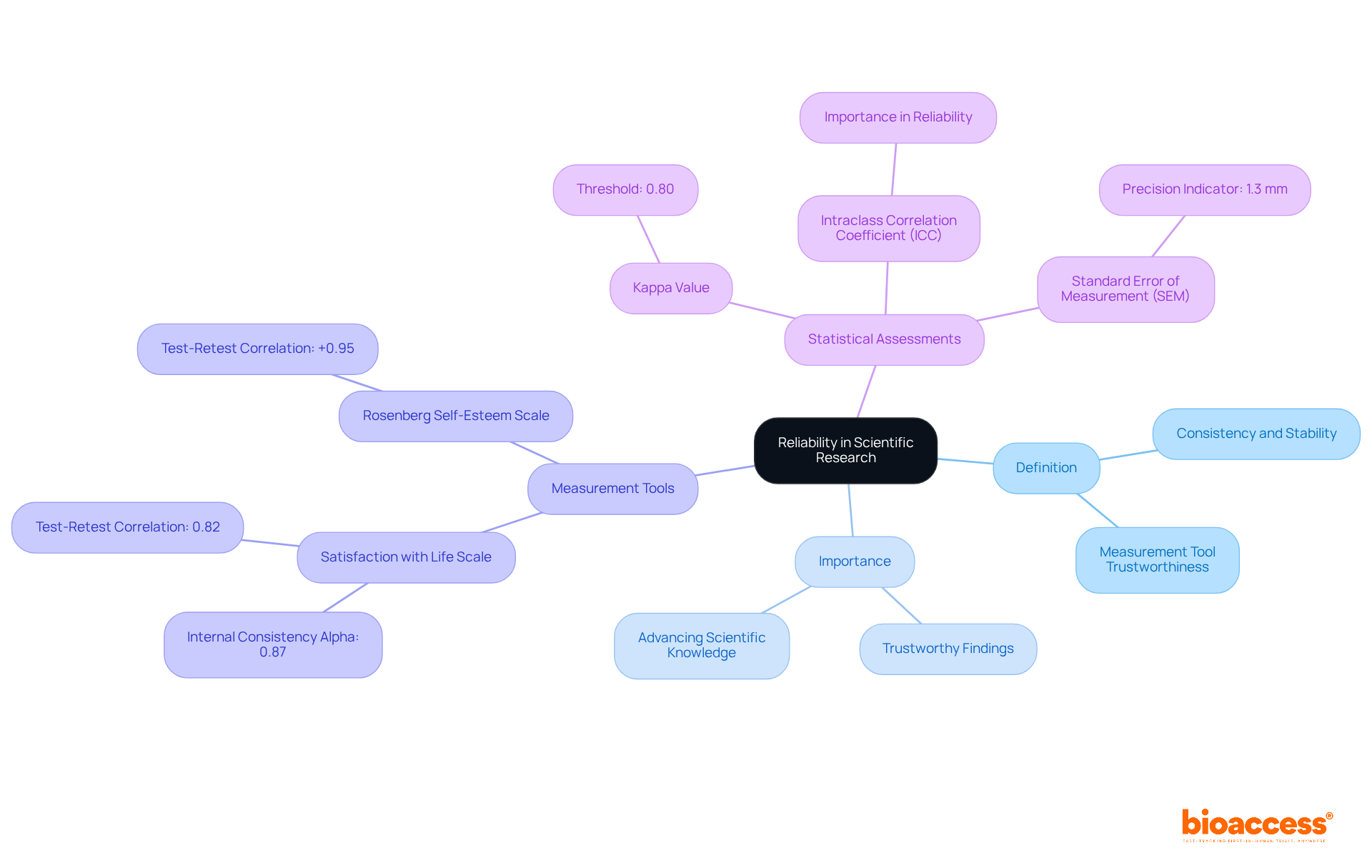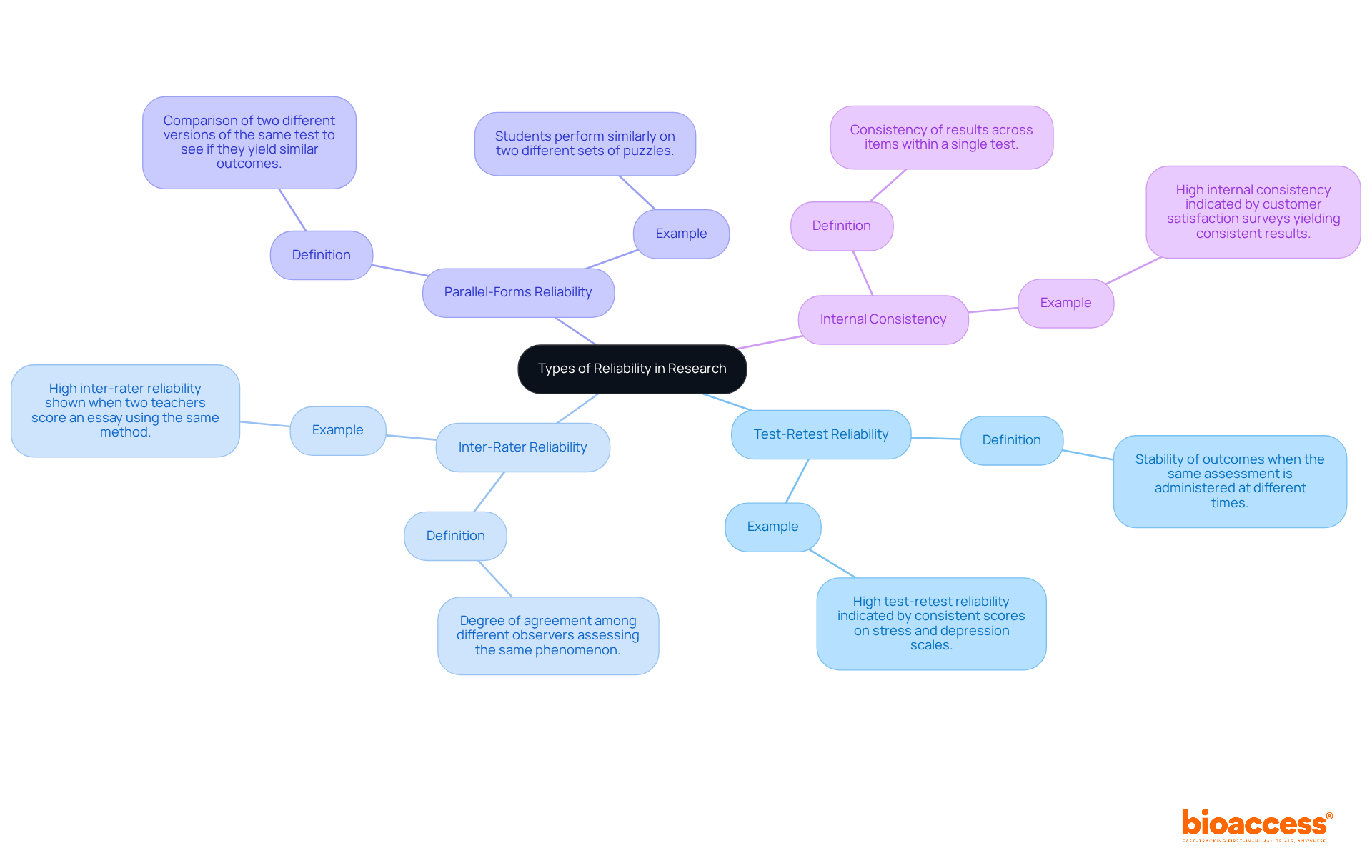


Understanding reliability in scientific research is essential for ensuring that findings are credible and replicable. This concept, defined by the consistency and stability of measurements over time, serves as a foundation for advancing knowledge across various fields. However, as researchers strive for dependable data, they often encounter the challenge of balancing reliability with validity—raising critical questions about the integrity of their findings.
How can researchers navigate this complex relationship to enhance the trustworthiness of their studies?
Reliability scientific definition in scientific research is crucial, characterized by the consistency and stability of evaluations or assessments over time. It reflects how well a measurement tool produces the same results under consistent conditions. For instance, a scale that consistently measures a weight as 10 kg demonstrates a high level of trustworthiness. This concept is vital for ensuring that study findings meet the reliability scientific definition, making them both trustworthy and replicable, which is essential for advancing scientific knowledge.
Statistical assessments indicate that a kappa value of 0.80 or greater is necessary to ensure the trustworthiness of clinical evaluations. Additionally, intraclass correlation coefficients (ICCs) are frequently utilized to evaluate the consistency of continuous assessment tools. In clinical studies, instruments like the Satisfaction with Life Scale, boasting an internal consistency alpha of 0.87, exemplify reliable measurement tools. Furthermore, the test-retest consistency of the Rosenberg Self-Esteem Scale, with a correlation of +0.95, underscores the importance of dependable data gathering instruments.
Nunnally's recommendation for a consistency coefficient of 0.90 is critical for significant decision-making in research contexts. Moreover, the standard error of measurement (SEM) of 1.3 mm indicates high precision in scores, emphasizing the importance of consistency in clinical environments. As we approach 2025, the focus on dependability remains paramount, as it not only enhances the trustworthiness of studies but also informs effective patient care and treatment choices.
Understanding systematic error in measurement dependability and the impact of various raters on measurement scores deepens our comprehension of consistency in studies. By prioritizing the reliability scientific definition, researchers can ensure that their findings meaningfully contribute to the field, ultimately benefiting patient outcomes.

The reliability scientific definition stands as a cornerstone of research, ensuring that findings are both consistent and trustworthy. High reliability not only bolsters trust in these findings but also empowers researchers to apply their conclusions to broader populations. For example, in clinical trials, precise measurements of patient outcomes are essential for evaluating the efficacy of new treatments. Reliability plays a critical role in selecting primary outcome measures for clinical trials and in determining eligibility and exclusion criteria.
Variable outcomes can raise significant questions about the legitimacy of studies, jeopardizing their impact and eroding confidence among stakeholders, including regulatory authorities and the community. The importance of dependable findings is highlighted by recent publications, such as the Reporting of Setting in Psychedelic Clinical Trials (ReSPCT) Guidelines, which stress the need for uniform reporting across trials to prevent the rejection of promising therapies. Furthermore, advancements in methodologies, such as robust randomization techniques, are vital for eliminating selection bias and ensuring comparability among treatment groups, thereby enhancing the trustworthiness of study results.
A compelling case study illustrates that inconsistent reporting can lead to the dismissal of promising therapies, as evidenced by the FDA's decision regarding MDMA-assisted therapy for PTSD. Ultimately, reliable studies form the backbone of scientific inquiry, validating results and fostering confidence in the conclusions drawn from data. The historical evolution of inquiry dependability has transformed since the 19th century, focusing on psychometrics and evaluation theory, which laid the groundwork for understanding consistency.
Dependability in research aligns with the reliability scientific definition, which refers to the trustworthiness of a study and is characterized by the consistency and stability of measurements—an essential factor for ensuring patient safety and treatment effectiveness in medical studies.

In research, understanding the various types of reliability is crucial for ensuring the validity of findings. Here are the key types:
Test-Retest Reliability: This type assesses the stability of outcomes when the same assessment is administered to the same group at different times. It’s essential for determining whether results are consistent over time.
Inter-Rater Reliability: This evaluates the degree of agreement among different observers or raters assessing the same phenomenon. High inter-rater reliability indicates that the measurement is reliable across different evaluators.
Parallel-Forms Reliability: This involves comparing two different versions of the same test to see if they yield similar outcomes. It’s particularly useful when assessing the reliability of tests that may vary in format.
Internal Consistency: This measures the consistency of results across items within a single test, ensuring that all items effectively measure the same construct. A high level of internal consistency is vital for the credibility of the assessment.
Comprehending these categories empowers researchers to select the most appropriate evaluation of consistency for their studies, ultimately enhancing the reliability of their research outcomes.

The connection between dependability and validity stands as a cornerstone of research integrity. The reliability scientific definition refers to the consistency of a measure, while validity assesses the accuracy of what that measure intends to evaluate. For instance, a scale that consistently provides inaccurate weight readings is reliable but not valid. In contrast, a valid measure, such as an intelligence test, must produce consistent results across various administrations to be deemed valid. This interdependence emphasizes that while a measurement can be dependable without being valid, a valid measure inherently necessitates what is known as a reliability scientific definition.
In clinical studies, the significance of both concepts cannot be overstated; they are vital for ensuring the quality and the reliability scientific definition of the findings. As we look ahead to 2025, the landscape of clinical investigation is evolving, yet the emphasis on strong validity and dependability remains paramount, particularly in the context of regulatory scrutiny and the need for reproducible results. Instances of valid and dependable measures encompass standardized evaluations in psychological studies and clinical trials that employ well-established diagnostic instruments. These not only boost the credibility of the study but also aid in the acceptance of findings within the scientific community.
Ultimately, the commitment to the reliability scientific definition and validity is crucial for advancing medical innovations and ensuring that research outcomes are both meaningful and applicable. As researchers, we must ask ourselves: how can we enhance our measures to ensure they are both reliable and valid? The answer lies in a collaborative approach, leveraging insights from the Medtech landscape to address key challenges in clinical research.

Understanding reliability in scientific research is crucial for ensuring that studies yield consistent and trustworthy results. The scientific definition of reliability underscores the significance of measurement tools that produce stable outcomes over time. By prioritizing this concept, researchers can bolster the credibility of their findings, ultimately contributing to advancements across various fields, especially in clinical settings where patient outcomes are at stake.
Key points throughout the article highlight different types of reliability—such as:
Each playing a vital role in validating research outcomes. The relationship between reliability and validity has also been examined, emphasizing that a valid measure must be reliable, while the reverse is not necessarily true. These insights illustrate the delicate balance required in research methodologies to foster trust and applicability in scientific inquiry.
As the research landscape continues to evolve, the commitment to reliability remains paramount. Researchers are urged to reflect on their methodologies and strive for improvements that ensure both reliability and validity. By doing so, the impact of their work can resonate far beyond the confines of their studies, ultimately enhancing patient care and fostering confidence in scientific advancements.
What is the definition of reliability in scientific research?
Reliability in scientific research refers to the consistency and stability of evaluations or assessments over time. It indicates how well a measurement tool produces the same results under consistent conditions.
Why is reliability important in scientific studies?
Reliability is crucial for ensuring that study findings are trustworthy and replicable, which is essential for advancing scientific knowledge.
What statistical measures are used to assess reliability?
A kappa value of 0.80 or greater is necessary for trustworthiness in clinical evaluations. Additionally, intraclass correlation coefficients (ICCs) are often used to evaluate the consistency of continuous assessment tools.
Can you provide an example of a reliable measurement tool in clinical studies?
The Satisfaction with Life Scale, which has an internal consistency alpha of 0.87, is an example of a reliable measurement tool.
What does the test-retest consistency of the Rosenberg Self-Esteem Scale indicate?
The Rosenberg Self-Esteem Scale has a test-retest consistency correlation of +0.95, highlighting its reliability as a data gathering instrument.
What is Nunnally's recommendation for a consistency coefficient in research?
Nunnally recommends a consistency coefficient of 0.90 for significant decision-making in research contexts.
What does the standard error of measurement (SEM) indicate in terms of reliability?
A standard error of measurement (SEM) of 1.3 mm indicates high precision in scores, emphasizing the importance of consistency in clinical environments.
How does understanding systematic error contribute to reliability in research?
Understanding systematic error in measurement and the impact of various raters on measurement scores enhances comprehension of consistency in studies, allowing researchers to ensure their findings are meaningful.
What is the significance of focusing on dependability in research as we approach 2025?
Focusing on dependability enhances the trustworthiness of studies and informs effective patient care and treatment choices, ultimately benefiting patient outcomes.